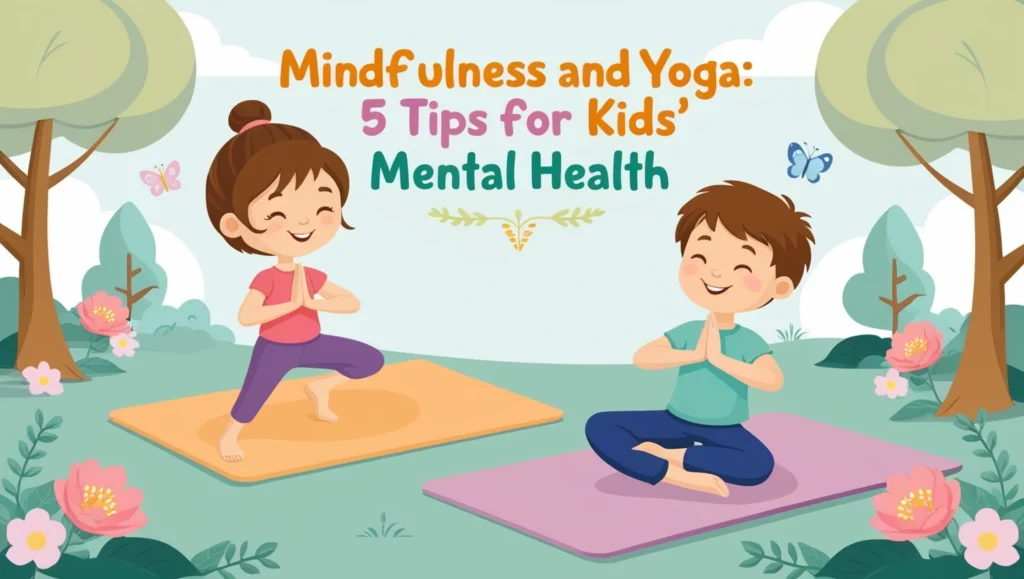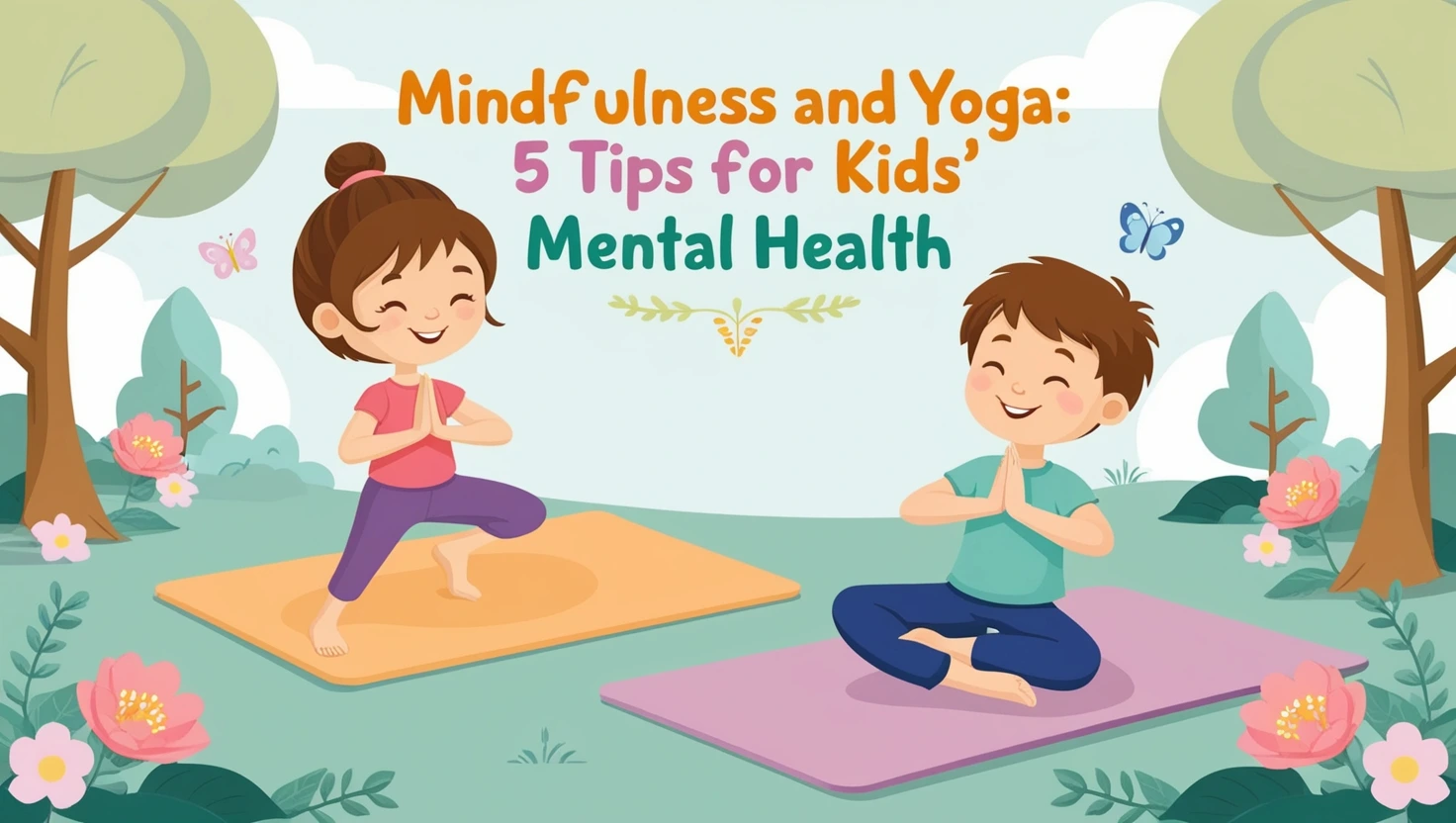In today’s fast-paced world, where kids are constantly exposed to technology, school pressures, and social distractions, it’s more important than ever to help children manage their mental well-being. Mindfulness and yoga are powerful tools that can help kids build emotional resilience, improve focus, and develop a sense of calm. By introducing these practices early, we can lay a strong foundation for mental health that lasts a lifetime.
Let’s explore 5 practical tips to help kids practice mindfulness and yoga for better mental health.

1. Practice Deep Breathing Exercises
One of the simplest yet most effective mindfulness techniques is deep breathing. This technique helps calm the nervous system, reduce stress, and improve focus. Teaching your child how to breathe deeply and mindfully can be a game-changer when it comes to managing big emotions like frustration or anxiety.
How to Do It:
- Encourage your child to sit in a comfortable position, close their eyes, and take slow, deep breaths.
- Guide them to inhale deeply through the nose for a count of four, hold the breath for a count of four, and then exhale slowly through the mouth for a count of six.
- Make this practice fun by pretending to “smell a flower” when they breathe in and “blow out a candle” when they exhale.
Why it Works: Deep breathing calms the mind and body, lowers stress levels, and helps children feel grounded in the present moment.
2. Simple Yoga Poses for Kids
Yoga is a wonderful way to promote flexibility, strength, and mental relaxation. Simple yoga poses can help children focus, calm down, and build self-awareness. You don’t need to be an expert yogi to introduce your child to basic poses.
Popular Poses for Kids:
- Tree Pose (Vrksasana): Stand on one leg, place the sole of the other foot against the standing leg, and bring the palms together above the head. This pose helps with balance and concentration.
- Cat-Cow Pose (Marjaryasana-Bitilasana): Begin on hands and knees, alternating between arching the back and rounding it. This pose is great for stretching and releasing tension.
- Butterfly Pose (Baddha Konasana): Sit with the soles of the feet together and gently flap the knees like butterfly wings. This pose stretches the hips and promotes relaxation.
Why it Works: Yoga helps children build strength, flexibility, and coordination, while also promoting relaxation and mindfulness. It encourages kids to be present, focus on their breath, and connect with their bodies.
3. Guided Meditation for Kids
Meditation is a wonderful way for children to learn how to calm their minds, reduce stress, and practice self-awareness. Guided meditation, where a parent or teacher leads the child through a calming story or visualization, is especially helpful for younger children.
How to Do It:
- Find a quiet space and encourage your child to sit or lie down comfortably.
- Guide them to close their eyes and imagine a peaceful place, like a beach or a forest.
- Use gentle, soothing language to help them visualize a calm and happy place where they can relax and feel safe.
Why it Works: Meditation helps children develop emotional regulation skills and can improve their ability to focus. It encourages them to let go of negative thoughts and worries, creating a sense of calm and peace.
4. Mindful Eating
Mindful eating is a fun and interactive way to help children develop awareness of their bodies and their food. This practice encourages them to slow down and appreciate the sensory experience of eating, which can improve digestion and promote a healthy relationship with food.
How to Do It:
- Sit down together and focus on the food in front of you.
- Encourage your child to notice the colors, textures, and smells of their food.
- Ask them to take small bites and chew slowly, paying attention to the taste and sensations.
- You can even make it a game by asking them to describe their food in creative ways!
Why it Works: Mindful eating teaches children to be present and fully engage with the food they are eating. It can reduce overeating and foster a positive attitude towards healthy food choices.
Read more:-
बच्चों के लिए मजेदार और शिक्षाप्रद जानवरों की कहानियां
Ancient Indian Scriptures: Teaching Kids the Secrets to a Happy Life
क्या बच्चों को देखनी चाहिए ‘भूल भुलैया 3’? जानिए इस फिल्म में बच्चों के लिए क्या है खास!
5. Daily Gratitude Practice
Practicing gratitude is an excellent way for kids to build emotional resilience and cultivate a positive mindset. By focusing on the things they are thankful for, children learn to appreciate the good in their lives and develop a sense of contentment.
How to Do It:
- Each day, encourage your child to share three things they are grateful for.
- These can be simple things like “I’m grateful for my pet” or “I’m thankful for playing with my friends.”
- You can make it a fun ritual by writing down the gratitude statements and keeping a gratitude jar where they can add their thoughts each day.
Why it Works: Gratitude practice promotes positive thinking and shifts the focus from what’s lacking to what’s abundant in life. It also helps kids manage stress and builds their emotional resilience.
Mindfulness and yoga are not just for adults—they can be incredibly beneficial for children, too. By incorporating simple techniques like deep breathing, yoga, meditation, mindful eating, and gratitude practices into daily life, we can help children develop the tools they need to manage stress, improve focus, and cultivate emotional well-being. These practices provide a foundation for mental health that will serve them well throughout their lives.
Introduce your kids to mindfulness and yoga in a fun and engaging way, and watch them grow into more mindful, relaxed, and resilient individuals.


